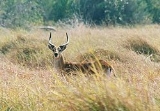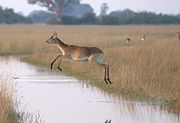
Lechwe
Encyclopedia

Antelope
Antelope is a term referring to many even-toed ungulate species indigenous to various regions in Africa and Eurasia. Antelopes comprise a miscellaneous group within the family Bovidae, encompassing those old-world species that are neither cattle, sheep, buffalo, bison, nor goats...
found in Botswana
Botswana
Botswana, officially the Republic of Botswana , is a landlocked country located in Southern Africa. The citizens are referred to as "Batswana" . Formerly the British protectorate of Bechuanaland, Botswana adopted its new name after becoming independent within the Commonwealth on 30 September 1966...
, Zambia
Zambia
Zambia , officially the Republic of Zambia, is a landlocked country in Southern Africa. The neighbouring countries are the Democratic Republic of the Congo to the north, Tanzania to the north-east, Malawi to the east, Mozambique, Zimbabwe, Botswana and Namibia to the south, and Angola to the west....
, south-eastern Democratic Republic of the Congo
Democratic Republic of the Congo
The Democratic Republic of the Congo is a state located in Central Africa. It is the second largest country in Africa by area and the eleventh largest in the world...
, north-eastern Namibia
Namibia
Namibia, officially the Republic of Namibia , is a country in southern Africa whose western border is the Atlantic Ocean. It shares land borders with Angola and Zambia to the north, Botswana to the east and South Africa to the south and east. It gained independence from South Africa on 21 March...
, and eastern Angola
Angola
Angola, officially the Republic of Angola , is a country in south-central Africa bordered by Namibia on the south, the Democratic Republic of the Congo on the north, and Zambia on the east; its west coast is on the Atlantic Ocean with Luanda as its capital city...
, especially in the Okavango Delta
Okavango Delta
The Okavango Delta , in Botswana, is the world's largest inland delta. It is formed where the Okavango River empties onto a swamp in an endorheic basin in the Kalahari Desert, where most of the water is lost to evaporation and transpiration instead of draining into the sea...
, Kafue Flats and Bangweulu Swamps.
Lechwe stand 90 to 100 centimetres at the shoulder and weigh from 70 to 120 kilograms. They are golden brown with a white belly. Males are darker in colour, but general hue varies depending on subspecies
Subspecies
Subspecies in biological classification, is either a taxonomic rank subordinate to species, ora taxonomic unit in that rank . A subspecies cannot be recognized in isolation: a species will either be recognized as having no subspecies at all or two or more, never just one...
. The long spiral structured horns are vaguely lyre-shaped, they are found only in males. The hind legs are somewhat longer in proportion than in other antelopes, to ease long-distance running in marshy soil.
Lechwe are found in marsh
Marsh
In geography, a marsh, or morass, is a type of wetland that is subject to frequent or continuous flood. Typically the water is shallow and features grasses, rushes, reeds, typhas, sedges, other herbaceous plants, and moss....
y areas where they eat aquatic plants. They use the knee-deep water as protection from predators. Their legs are covered in a water repelling substance allowing them to run quite fast in knee-deep water.
Lechwe are diurnal
Diurnal animal
Diurnality is a plant or animal behavior characterized by activity during the day and sleeping at night.-In animals:Animals that are not diurnal might be nocturnal or crepuscular . Many animal species are diurnal, including many mammals, insects, reptiles and birds...
. They gather in herds which can include many thousands of individuals. Herds are usually all of one sex but during mating season they mix.
Subspecies
Traditionally, four subspecies of the Lechwe have been recognized. Additionally, the Upemba LechweUpemba Lechwe
The Upemba Lechwe, Kobus anselli, is a species of antelope found only in the Upemba wetlands in the Democratic Republic of Congo. It was described in 2005, after analysis of thirty five museum specimens collected in 1926 and 1947-8. It was previously overlooked due to its similarity to the Lechwe...
, which only was described in 2005, is treated as a subspecies of the Lechwe by some authorities.
- Red Lechwe or Zambesi Lechwe (Kobus l. leche) - most of range. Overall tawny-fawn with black to front of front legs.
- Kafue Lechwe or Brown Lechwe (Kobus leche kafuensis) - Kafue Flats. As previous, but front legs almost entirely black. VulnerableVulnerable speciesOn 30 January 2010, the IUCN Red List of Threatened Species identified 9694 Vulnerable species, subspecies and varieties, stocks and sub-populations.-References:...
. - Roberts' LechweRoberts' LechweRoberts' lechwe or Kawambwa lechwe is an extinct subspecies of lechwe. It was found around Kawambwa, Zambia, but no populations now survive....
or Kawambwa Lechwe (Kobus leche robertsi) - formerly near KawambwaKawambwaKawambwa is a town in the Zambian province of Luapula located on the edge of the northern Zambian plateau above the Luapula valley at an altitude of 1300 m...
. Extinct. - Black Lechwe or Bangweulu Lechwe (Kobus leche smithemani) - Bangweulu Swamps. Adult male blackish. Vulnerable.

